Thiruvananthapuram Metro Rail – A Concept Plan
How would a Metro rail network for Kerala's capital city look like?
Thiruvananthapuram, also known as Trivandrum for those who don’t have a penchant for Malayalam tongue twisters, is the capital city of the southern state of Kerala in India. It has a very rich, illuminating history, heritage and cultural treasures, and boasts of a cuisine that is often widely appreciated. But what it does not have is a public transport system. In fact, Thiruvananthapuram is the only place in Kerala where you will find it difficult to go about your day to day work without a personal vehicle. It is imperative that it Thiruvananthapuram has a metro rail network like many other state capitals.
Kerala is generally extremely well connected by all modes of public transport, be it trains, buses and boats, but with the exception of the capital. Among the reasons are increasing prosperity leading to migration by the newly affluent from public to private transport as the preferred and sometimes only mode of transport. It does not help that the KSRTC has a monopoly on both local and long-distance bus services, as opposed to the rest of the state which has a thriving private bus network. The only thing KSRTC’s services do is drive people away from public transport. The result has been the conversion of Thiruvananthapuram into a car-dependent city with roads filled with cars and two-wheelers and where buses are conspicuous by their absence.
As we are witnessing a metro-building boom across India, and almost all of those projects turning into super hits, Thiruvananthapuram should also get its own mass-transit system to join the rest of the modern world. A “light” metro railway project was proposed for the city around eight years ago, and has been sleeping in cold storage ever since. The Kochi Metro that was proposed around the same time has since been completed and gone into service which has been a blockbuster hit with a consistent daily ridership of around 60,000 for its 18-km stretch. However, the capital’s metro has never seen the light of the day.
It is high time that this be revived and re-planned to consider changed and future requirements, because any further, and the idyllic capital city known for its conservativeness and calm pace of life will devolve into a traffucked mess. Given that it is the capital city and tourist hub with people from all over the state, country and the world visiting it, it is imperative that the city gets a modern mass transport system instead of being stuck with 100-years old ancient technology like cars to move people.
A Complete Thiruvananthapuram Metro Rail Transit System Concept
Thiruvananthapuram is especially suited for a mass transit option like the metro rail as its travelling population mostly consists of fixed-route commuters who take the same, predictable route in the morning and evening. This is because the city has little other industrial or economic activity than government offices, the East fort area and Thampanoor, and the Technopark. Most of the city’s commuting pattern consists of private and public vehicular transport flowing in and out of these three locations. It is hence easy to design a network, even. So, here is a proposal and concept for a fully-fledged metro rail system (and not just “light”, we will come to that later) for the city of Thiruvananthapuram, Kerala, India.
This concept plan for the Thiruvananthapuram metro rail network will consist of three lines, which we name Red, Green and Blue, totalling to about 73 km with 74 stations. The network is designed based on the city layout, commuting patterns, traffic flows, destination hotspots and population distribution of the city and surroundings, and its future potential growth. Three-coach metro trains could run services with five to ten minutes headway depending on the crowd. For a city as congested like Trivandrum, it could be more feasible to run shorter trains at reduced intervals which help to keep station design and footprint smaller and simpler. Most of the line will have to be overground, especially in the city centre for reasons well-known.
Please note that this is only a figment of imagination and for most not a plan in any official capacity. The difference is that unlike the Bangalore plan, this one is actually implementable and feasible.
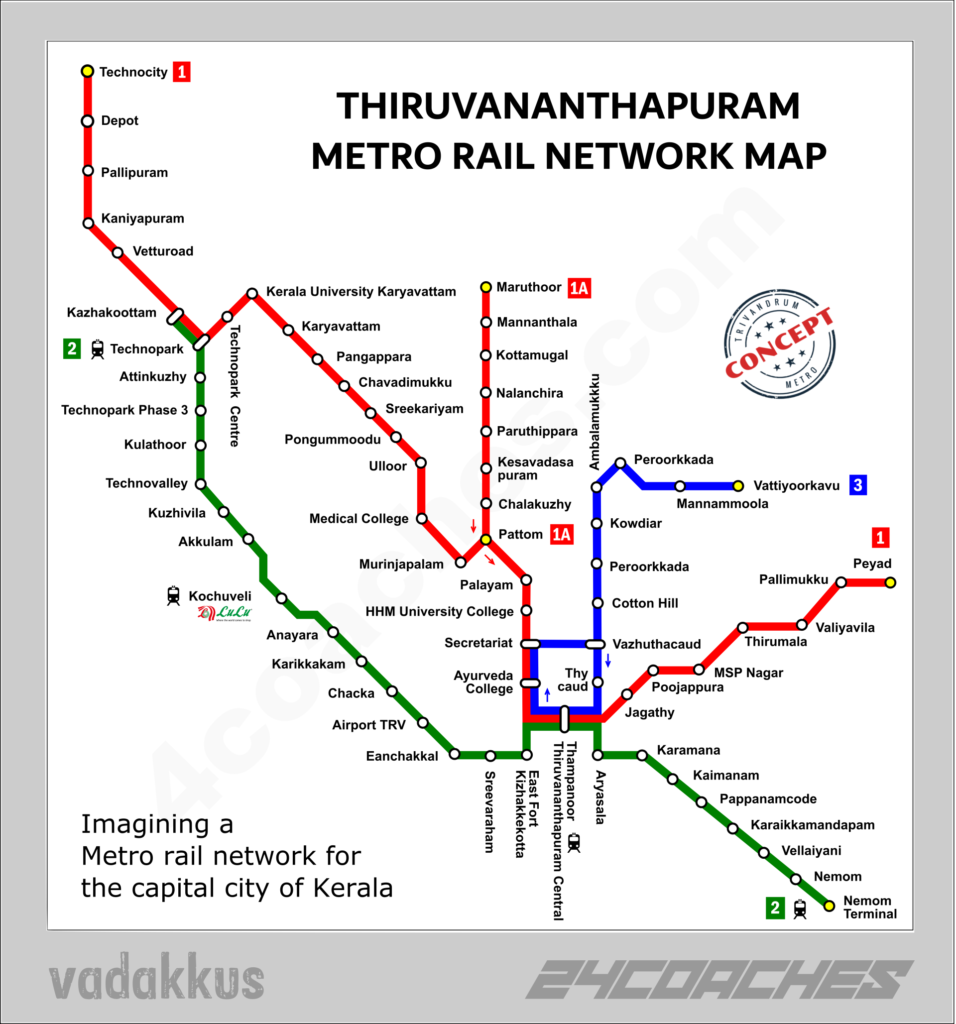
The Red Line – Pallipuram to Peyad – 32 km
This line is a part of the original plan for the light metro rail system that was proposed. Simply put it follows the main traffic artery across the city. It starts at the Technocity at Pallipuram which is beyond city limits, on the highway from Thiruvananthapuram to Kollam. It is the location of a massive upcoming IT and technology hub. From there it will come to Kazhakoottam the fastest growing part of the city and IT corridor with the Technopark and other large technology companies. The Technopark was initially amazingly not included in the plan for the Metro which stuck to the bus route out of Kazhakoottam, but this plan does. From there, the line rejoins the old National Highway and main artery into the city, passing Sreekaryam, Ulloor and the Medical College to arrive at Pattom from where it will reach Palayam to enter the CBD and onwards to the Secretariat (Statue) and along the MG Road to reach Thampanoor, the City’s transit hub, its “Majestic”, with the railway station and bus terminus situated opposite each other. It will connect with the other two lines here as an interchange point. From here it will continue into the middle-class residential areas of Jagathy, Poojappura, Thirumala and Pangode, to terminate in the suburb of Peyad. The line will serve the most-travelled corridor of the city.
Stations (30): Technocity, Depot, Pallipuram, Kaniyapuram, Vettu Road, Kazhakoottam, Technopark Main, Technopark Centre, Kerala University Karyavattam, Karyavattam, Pangappara, Chavadimukku, Sreekariyam, Pongummoodu, Ulloor, Medical College, Murinjapalam, Pattom, Plamoodu, Palayam, HHM University College, Secretariat, Ayurveda College, Thampanoor Thiruvananthapuram Central, Jagathi, Poojapura, MSP Nagar, Thirumala, Valiyavila, Pallimukku, Peyad.
The Red Line Branch (Pattom – Maruthoor) 6 km
The red line will have to have a branch line as well, coming in along the MC Road from Maruthoor near Vattappara to join the line at Pattom and continue onwards. This is a high-income locality and with the educational complex at Nalanchira the line will have high ridership. Passengers towards Medical College and Kazhakoottam can connect to the main 1 line at Pattom.
Stations (7): Pattom, Chalakuzhy, Kesavadasapuram, Paruthippara, Nalanchira, Kottamugal, Mannanthala, Maruthoor.
The Green Line (Kazhakoottam – Nemom) 23 km
The green line connects the newest and the oldest parts of the city. It could be the pulsing nerve cord serving “New Trivandrum” as it is now being called, the Kazhakoottam – Enchakkal bypass. It connects the IT Corridor, three railway terminals, the airport, the largest Mall and the old city. It starts ta Kazhakoottam and runs along the bypass road, serving Technopark Phase 1 entrance, Phase 3, the UST and Infosys campuses, running through the latter three campuses rather than along the Bypass Road, because it has to be serving the campuses directly. The Lulu Mall and Kochuveli railway terminus share a station. It then continues along the Bypass road and through the Airport, then easing past Eanchakkal into the the old city serving Sreevaraham, the East Fort, Thampanoor and Aryasala, continuing along the old commercial hotspot south of Thampanoor along the highway to Kanyakumari, terminating at the upcoming Nemom railway terminal.
Stations (25): Kazhakoottam, Technopark Main, Attinkuzhi, Technopark Phase 3, Kulathoor, Technovalley, Karimanal, Akkulam, Kochuveli, Anayara, Karikkakam, Chackai, TRV Airport, Eanchakkal, Sreevaraham, East Fort/Kizhakkekotta, Thampanoor/Thiruvananthapuram Central, Karamana, Kaimanam, Karakkamandapam, Vellaiyani, Nemom, Nemom Terminus.
The Blue Line (Vattiyoorkkavu – Thampanoor) 12 km
The blue line is a necessary addition that will help to massively decongest the city by connecting its most affluent areas and upper middle class localities such as Vattiyoorkkavu, Mannammoola, Peroorkkada and surroundings with the tony parts of the CBD such as Kowdiar, Vellayambalam, Vazhuthacaud, in addition to the Secretariat and Thampanoor. It also features a unique circular layout that runs in only one direction along with the red line from the Vazhuthacaud to Thampanoor and the Secretariat, rejoining at Vazhuthacaud.
Stations (12): Vattiyoorkkavu, Mannammoola, Peroorkkada, Ambalamukku, Kowdiar, Vellayambalam, Cotton Hill, Vazhuthacaud, Thycaud, Thampanoor/Thiruvananthapuram Central, Ayurveda College, Secretariat.
Some Major Stations
Pallipuram is heartening that the project takes into account the upcoming “Technocity” IT project and has chosen it to be one of the starting points of the Metro, even when it is far outside city limits. The servicing depot for the Metro is also located nearby.
Kazhakoottam has to be among the fastest growing urban areas in the country, Thiruvananthapuram’s Whitefield if you will. It is home a massive floating population employed in the IT corridor and as such the prime location for a transit hub. The green line can originate from here.
The Kochuveli railway terminus suffers from The Indian Railways typically plan these things taking into consideration only the operational parts and not ever passenger convenience. One of the country’s largest malls is going to suffer from a connectivity nightmare. Eventually they will realise that it is people who bring footfalls, and not cars. This station can be shared with the Lulu mall with a 500m-walkway connecting both locations.
The three lines form a closely interlinked network that covers all of the Central Business District that consists of three parts; one is the old city served by the Aryasala, East Fort and Sreevaraham stations on the Green Line, the “centre” of the city: Palayam, Secretariat, MG Road, Thycaud and Vazhuthacaud served by the Red and Blue lines and all the lines converging at Thampanoor leading to the next-level development of the state’s famous transit hub of the central railway station and bus terminus.
Connecting Technopark and Other IT Hubs
The Technopark is arguably the most important location that can be serviced by a Metro line in the city because of it being the destination target for thousands of commuters everyday. The Technopark, Trivandrum is Asia’s largest Technology park (by area), employing more than 60,000 people in 400+ companies ranging from 1-person startups to the 5000+ UST Global and Infosys. But incredibly, the Technopark was not even considered in the initial plan for the light metro!
There is enough scope for not one, but two stations for the phase 1 campus, one at the entrance gate and another at possibly where the current guest house is located, centrally located to ensure access to all buildings via walkways. Further, the Green line could directly connect Phase 3 and the new mall next to it. The Technovalley station could come up at the midpoint in between the UST and Infosys campuses, serving both. This alone will ensure all of the Trivandrum Metro will be in profit with not much delay.
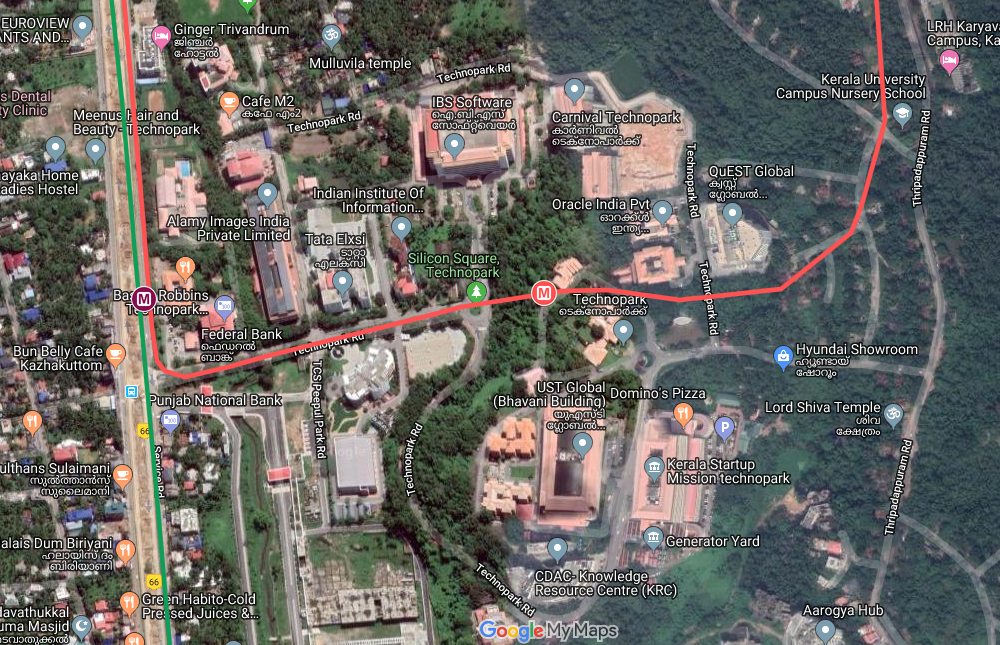
The development of the state-of-the-art four-lane bypass road in the recent years has spurred a very-high growth phase for the Technopark. And where is this growth is very apparently visible? In form of the large crush of cars and motorcycles in the campus, of course. This is because in addition to the general penchant for the “I go to office in my own car” vanity of today’s affluent populace, the Technopark actually has very little to no public transport connectivity. You only have three or four buses reaching the “Park” every day, and there are nearly no timetables or departure details posted anywhere. So everyone comes to office by car or two-wheeler, and mostly all cars are single-occupant. Parking lots are larger than buildings, every flat surface including all roadsides and footpaths are crowded with parked vehicles of all kinds, there is no space to even walk.
As the commuting destination for a large number of people the Technopark can be a huge captive audience for a metro rail project, being the most efficient way to move people to their places at work and back. In addition, since techies do not usually work by-the-clock like say, government employees, a mode of transportation that runs at regular frequencies will be an excellent fit. This is why with 50,000 probable regular commuters, it has a scope for not one but two Metro stations. But the metro is not just about congestion and pollution, but about other more organic things like economics, quality of life and efficiency.
Places like IT parks which depend of the presence of large number of people for their growth cannot grow beyond a point if sustainable public transport is not on offer, because they can accommodate only so many cars and parking. And the time will not be far away when growth of the Technopark starts to stagnate and stop because there simply is not enough space to build office buildings (there is currently a waiting list of 170 odd companies wanting office space in Technopark, but they can’t because there is not enough space inside buildings. And there are not enough office space but also because there aren’t enough parking spots. The growth of Technopark will be limited by its parking slots.
When space is at such a premium, it is a criminal to waste large open areas simply for parking as if it were the Gulf. For instance, if a one-acre plot where easily a 20000 sq ft per floor office building can be constructed is used to park around 150 cars, employment for around 10000 people is being denied in the name of parking for 300 people. This might be an extreme example, but unfortunately true.
In a way, it is not really surprising that Technopark was never even a part of the plan for the Thiruvananthapuram Metro because if you look at it, no IT parks anywhere in India have their dedicated mass rail transit heads! This is for the simple reason of a societal mentality that considers the private car the default mode of personal transportation, and public transport for those weaker sections of the society. Since IT employees are all rich, and can anyway afford to drive to office, why should IT parks have Metro stations, right? I have heard this mentality echoed several times in Bangalore, Ernakulam and Thiruvananthapuram, sometimes even in an official capacity. One could implore the authorities to please connect the Technopark with the Metro. Techies are actually the target market for the Metro project as they will be really the ones who will be able to afford the tickets. Please?
Why the Metro?
The people of Thiruvananthapuram consider the city as a destination unaffected by traffic congestion that has become the defining feature of large cities like Bangalore. That is no longer true. The city is jammed with private vehicles. Cars choke its narrow roads, parking has reduced driving space to one and a half lanes, roadsides lined by the metal walls of parked cars. Except the PMG-Vellayambalam-Kowdiar stretch, all roads are extremely narrow and congested. Heavy pollution is a bonus. Huge traffic snarls are witnessed in all entry points to the city be it at Kazhakoottam, Chacka, Eanchakkal, Balaramapuram, Peroorkkada, Sreekariyam, etc.
As much as Malayalees like to think that traffic problems can be “solved” by building flyovers and widening roads, but unfortunately that does not happen. It hasn’t anywhere in the world, ever. A city is considered “modern” and “livable” when it has a viable, sustainable and efficient mass transit system. No city can grow or sustain and provide a decent quality of life for its citizens, or hope of turning into an economic power without one, and more so when it is as densely populated and mobile like Kerala. Large number of private cars signal only inefficiency and individual selfishness and not a society’s economic clout.
It is perfectly understandable that people after attaining a certain level of prosperity would want to reward themselves for their troubles with comfortable and “matching their status” transportation options. The average very affluent Malayalee considers a private car as the ultimate spoil of prosperity and has come to regard it as the default and in many cases the only viable mode of transportation. But what is sad is that the people of the illustrious capital city of the Kerala often seem to be ambivalent about the Metro or even consider it unnecessary, rather wanting “wider” roads to “solve blocks” because the “best” public transport they have ever experienced are KSRTC’s ramshackle ordinary city buses which do not cut it in any way. Few people realise that this will only lead to a highly frustrating and “blocked” future. This is why the Metro, which will entice the “rich” commuter to get back on public transport. A city’s public transport should mirror the aspirations of its people. And of course, for that future’s sake, the Metro has to be a “full” Metro, not a half-baked “light” metro. Why do we Indians insist on doing infrastructure halfway?
As of now, the city planners give scant regard to public transport. The newly completed Bypass road stretching south from Kazhakoottam is something like an access controlled highway with no provision whatsoever for public transport (bus stops, walkability). The road itself is isolated by an elevated position with large guardrails and wide and deep ditches on both sides. People have to cross the road by means of rickety makeshift ladders. It passes through heavily populated and travelled communities on both sides. Kerala’s premier IT corridor with the massive Technopark campuses lie on this road, and is an upcoming heavy-duty commercial area with a number of large apartments, hotels, malls (including the biggest in Kerala), a railway terminal and the airport. The area is being planned as a completely car-accesible facility only, which will only spell doom for the future, if experiences of other Indian cities are anything to go by. The bypass requires a metro line of its own. And this is the green line.
With their close association with car-rich places like the Gulf, the USA, Canada and Australia and NZ, Malayalees have come to consider owning and driving cars the absolute-end to life and prosperity, and believing that public transport is for “poor people” who cannot afford their own car or motorcycle, stop-gap arrangements until the day of final judgement when everyone will be able to afford their own vehicle, a view increasingly echoed by the government as well. This is a recipe for a future disaster.
The other day someone told me that Thiruvananthapuram is going to be the next Bangalore and the Bypass road will be the Outer Ring Road (or the Sheikh Zayed Road, even!). I shuddered when I realised that this could be actually true! The Bypass road is now at the same stage where the Outer Ring Road was in 2004, an awesome stretch of six-laned road with hardly any obstructions. Ten years later had turned into a terror and today it has turned into a horror. The bypass will be at that stage in another five. They first installed signals and then built flyovers on the ORR at thinking it will “solve” traffic problems, but we have all seen what happened. Now a metro is being planned on the Bangalore Outer Ring Road, around 15 years too late.
Thiruvananthapuram has started to hilariously repeat that history. Traffic signals were installed soon after the stretch was opened and now they have started building flyovers. As the city is beginning to get clogged with vehicles, this is the right time and way to plan for the future, before it is too late. Otherwise all so-called development will end up stuck in traffic.

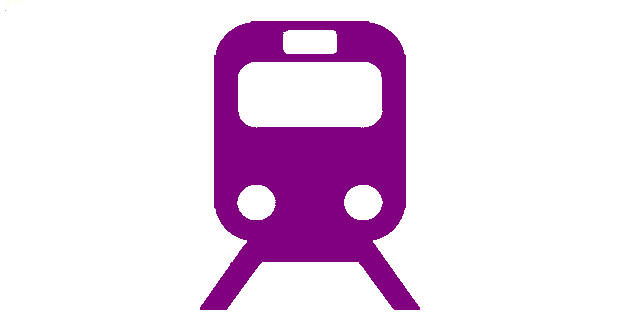
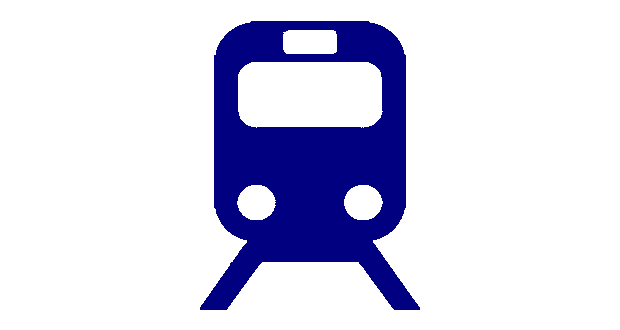
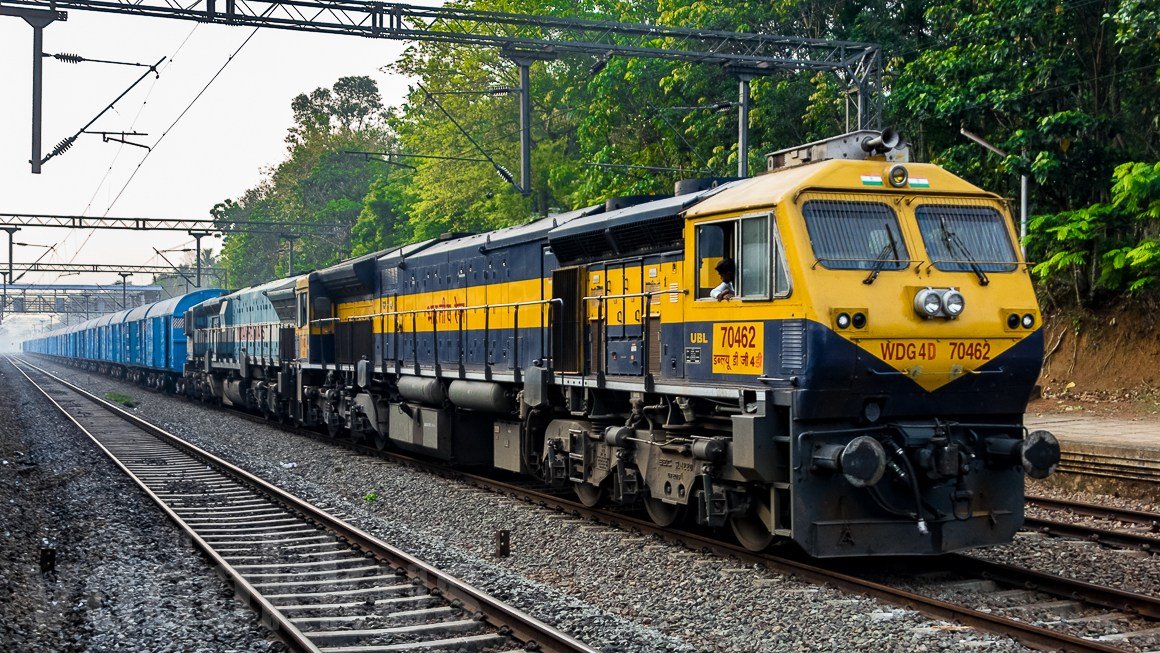
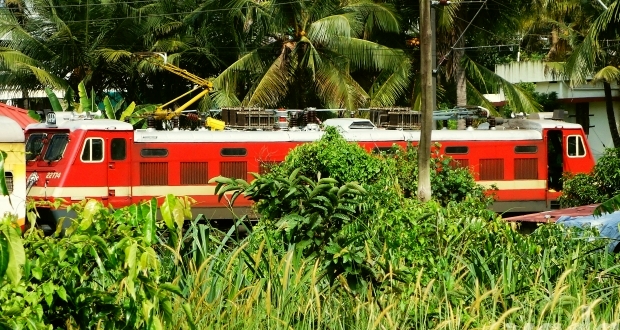
Awesome post! Keep up the great work! 🙂